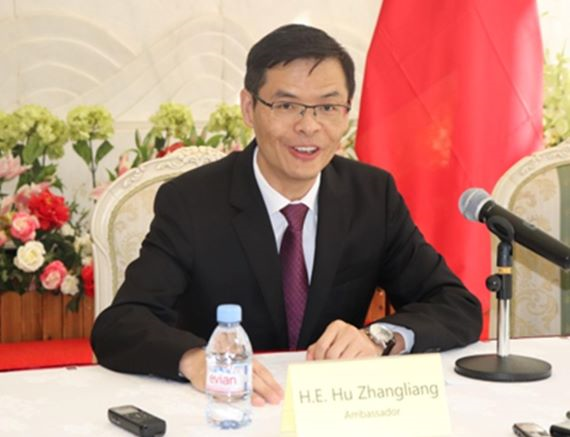By Hu Zhangliang Chinese Ambassador to Sierra Leone
FREETOWN, Nov. 15 (232news.com) – In June 2015, the Chinese government submitted the Enhanced Actions on Climate Change: China’s Intended Nationally Determined Contributions under the United Framework Convention on Climate Change (UNFCCC). China determined its actions to achieve the peaking of CO2 emissions around 2030 and making best efforts to peak early, and intended that by 2030, to lower CO2 emissions per unit of GDP by 60% to 65% from the 2005 level, to increase the share of non-fossil fuels in primary energy consumption to around 20% and to increase the forest stock volume by around 4.5 billion cubic meters on the 2005 level.
To achieve the goals, China has formulated relevant polices and taken serious measures in a wide range of sectors. In terms of climate action, China’s carbon intensity (CO2 emission per unit of GDP) in 2019 was 51.9% of that in 2005, a decrease of about 48.1% from 2005. It outperforms the 2020 goal of cutting CO2 emissions per unit of GDP by 40–45% from the 2005 level, and represents a cumulative reduction of about 5.7 billion tons in CO2 emissions. This basically reverses the fast growth trend of CO2 emissions and makes a huge contribution to the global response to climate change.
In 2019, non-fossil fuels accounted for 15.3% of China’s energy consumption, a significant increase of 7.9% over 2005. According to the ninth National Forest Inventory (2014-2018), China’s forest coverage rate registered 22.96% and forest stock volume reached 17.56 billion m3, rendering the largest growth in green space among all countries.
In the past ten years, China phased out 120 million kilowatts of installed coal-fired power generation capacity. The construction of the first batch of wind and photovoltaic power stations with a total installed capacity of about 100 million kilowatts was launched in an orderly fashion.
In terms of adapting to climate change, the effective irrigation area of farmland in China expanded from 55 million hectares in 2005 to 68.3 million hectares in 2019, and the effective utilization coefficient of agricultural irrigation water increased from 0.45 to 0.56 in this period, which has enhanced climate resilience of agricultural production.
China is also doing what it can to help build up climate response capabilities in developing countries. From supporting Africa in monitoring the climate system with satellite technology and building low-carbon pilot zones in South-East Asia, to introducing energy-saving bulbs to small island countries, China’s cooperation with less developed regions of the world has produced tangible results. China has also launched green action initiatives that encourage green infrastructure, energy, transportation and finance under the Belt and Road Initiative (BRI) framework. In 2020, 57% of China’s energy investment in BRI partner countries went to renewable energy projects, up from 38% in 2019. Such efforts will continue.
Based on the remarkable achievements, China set more ambitious targets for itself. At the general debate of the 75th Session of the United Nations General Assembly on September 22, 2020, President Xi Jinping announced that China would scale up its Nationally Determined Contributions (NDCs) by adopting more vigorous policies and measures, strive to peak CO2 emissions before 2030, and achieve carbon neutrality before 2060.
On December 12, 2020, President Xi Jinping announced some further commitments for 2030 at the Climate Ambition Summit: China will lower its CO2 emissions per unit of gross domestic product (GDP) by over 65% from the 2005 level, increase the share of non-fossil fuels in primary energy consumption to around 25%, increase the forest stock volume by 6 billion m3 from the 2005 level, and bring its total installed capacity of wind and solar power to over 1.2 billion kW.
Recently, the above commitments were reiterated by H.E. President Xi Jinping in September this year at the UN general assembly, with the further announcement that China will not build any more coal-fired power stations overseas. In his written statement at the just-concluded World Leaders Summit at the COP26, President Xi stressed that China will continue to prioritize ecological conservation and pursue a green and low-carbon path to development.
The international community should recognize that, for a developing country with a population of over 1.4bn that has not completed industrialization or urbanization, the nationally determined contributions (NDCs) and the supporting policy measures that China has adopted voluntarily have not been easy. Developed countries with hundreds of years of industrialization behind them and historical environmental debts should make bigger contributions to tackling pollution and protecting the environment, instead of pinning the responsibility on China and other developing countries.
According to statistics published by Center for Global Development, from 1850-2011, developed countries are responsible for 79% of historical Carbon emissions. The United States has emitted more CO2 than any other country to date: 400 billion tonnes since 1751, which means it is responsible for 25% of historical emission with only 4.25% of the world’s total population. European Union is also a large historical contributor at 22%[1]. In terms of cumulative per-capita emissions, China, India, Brazil and Indonesia, which account for 42% of the world’s population, take up 23% of cumulative emissions from 1850-2021.
The principles of equity – common but differentiated responsibilities and respective capabilities – should be upheld. Developed countries must shoulder their obligations and take the lead in drastically cutting emissions – a key to achieving global net-zero emissions. They also need to help developing countries speed up the green and low-carbon transition by significantly increasing support to them through financing, technology and capacity building, and avoid putting up green trade barriers.

